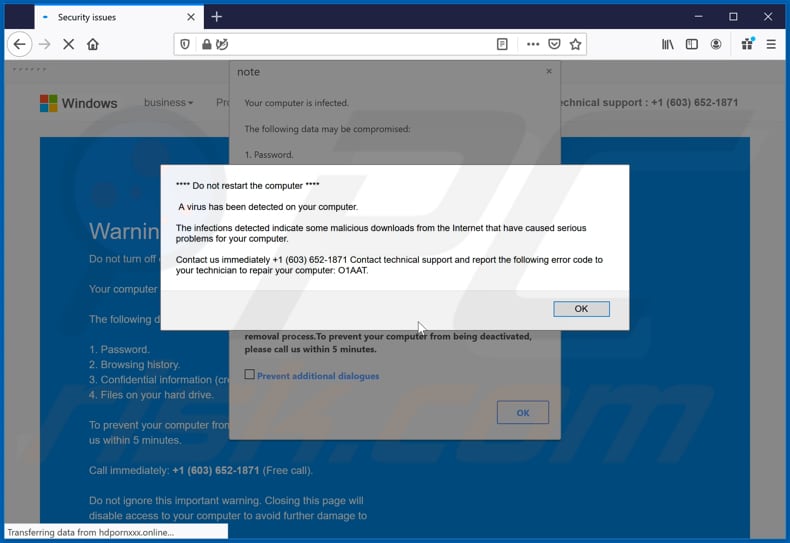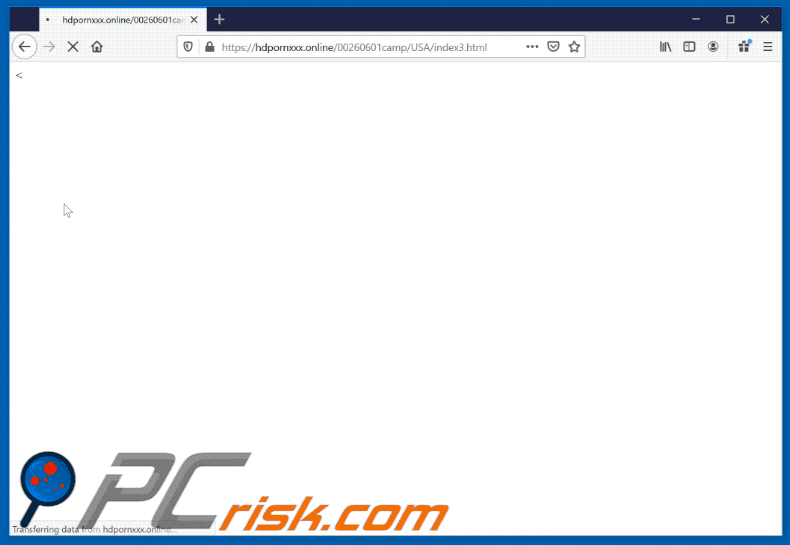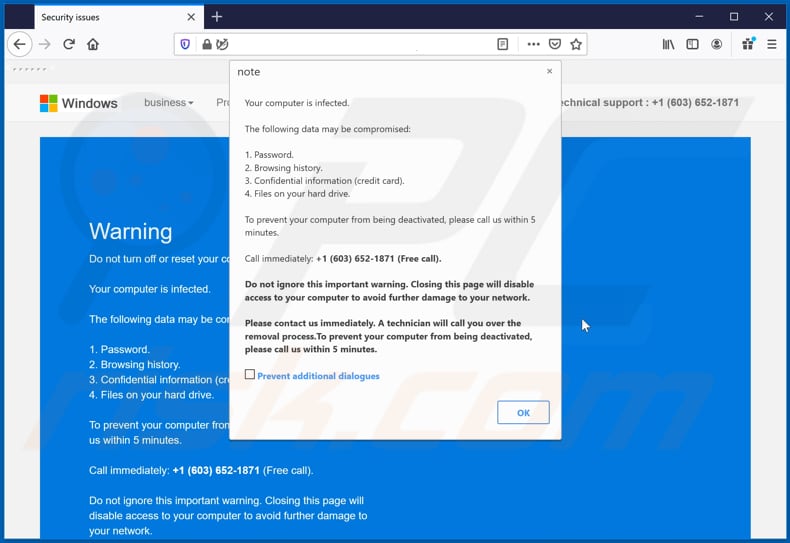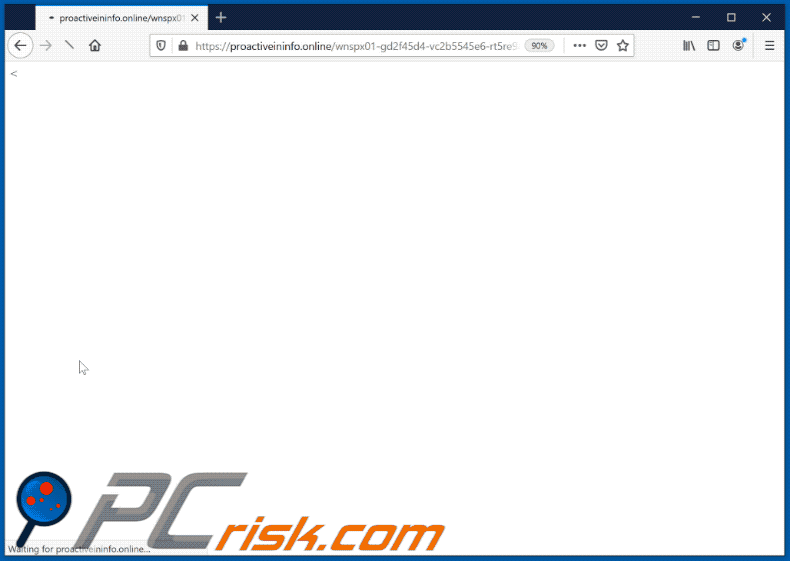Avoid the scam entitled "A virus has been detected on your computer"
Phishing/ScamAlso Known As: A virus has been detected on your computer tech support scam
Get free scan and check if your device is infected.
Remove it nowTo use full-featured product, you have to purchase a license for Combo Cleaner. Seven days free trial available. Combo Cleaner is owned and operated by RCS LT, the parent company of PCRisk.com.
What is "A virus has been detected on your computer"?
This is a typical tech support scam in which criminals claim to offer a legitimate technical support service.
Typically, the scammers responsible attempt to trick unsuspecting users into paying for supposedly legitimate software or services, or even installing a Remote Administration Tool (RAT), which would allow them to remotely access and control computers. In any case, you are strongly advised to ignore such scams and never trust the messages.

The main purpose of this technical support scam is to trick people into believing that their computers are infected with a virus and calling the +1 (603) 652-1871 number. It claims that a detected virus might compromise data such as passwords, browsing history, files stored on the computer, and other confidential information.
To prevent possible damage, users are urged to call the provided number within five minutes. This scam website may seem similar to an official Microsoft web page, however, none of the official Microsoft sites have anything to do with this site.
Typically, criminals behind these scams attempt to deceive people into paying for so-called "support" services or software and giving remote access to their computers. Through such access, the scammers might be capable of stealing sensitive information such as credit card details, passwords, installing malware (like ransomware, Trojans), accessing personal files, etc.
They can then misuse the accessed information to steal identities, personal accounts, make fraudulent purchases, transactions, and so on. You should ignore these scams. Note that users do not open these scam pages intentionally - in most cases, they are opened through other dubious websites, clicked deceptive ads, or by installed potentially unwanted applications (PUAs).
PUAs can open untrusted web pages and also collect various data relating to users' browsing habits. For example, IP addresses, entered search queries, addresses of visited pages, and geolocations.
In some cases, they target sensitive, personal details as well. Furthermore, PUAs often serve intrusive ads (coupons, banners, surveys, pop-ups, etc.), which can open untrusted web pages or even run scripts designed to download/install other unwanted software.
| Name | A virus has been detected on your computer tech support scam |
| Threat Type | Phishing, Scam, Social Engineering, Fraud. |
| Fake Claim | This scam claims that the user's computer is infected with a virus. |
| Tech Support Scammer Phone Number | +1 (603) 652-1871, 0808-143-3686 |
| Related Domains | hdpornxxx[.]online, proactiveininfo[.]online |
| Serving IP Address (hdpornxxx[.]online) | 198.187.31.101 |
| Symptoms | Fake error messages, fake system warnings, pop-up errors, hoax computer scan. |
| Distribution methods | Compromised websites, rogue online pop-up ads, potentially unwanted applications. |
| Damage | Loss of sensitive private information, monetary loss, identity theft, possible malware infections. |
| Malware Removal (Windows) |
To eliminate possible malware infections, scan your computer with legitimate antivirus software. Our security researchers recommend using Combo Cleaner. Download Combo CleanerTo use full-featured product, you have to purchase a license for Combo Cleaner. 7 days free trial available. Combo Cleaner is owned and operated by RCS LT, the parent company of PCRisk.com. |
More examples of similar scams are "ERROR CODE 72", "Your Windows Is infected With (3) Viruses!" and "VIRUS ALERT FROM Windows".
Typically, these scam pages are disguised as official Microsoft websites claiming that they have detected a virus, error, etc., and encouraging users to call the provided number immediately. As mentioned, users do not often visit these sites intentionally. If your browser opens dubious, deceptive web pages automatically, it is likely that a PUA is installed.
How did potentially unwanted applications install on my computer?
Potentially unwanted applications are distributed using the download and installation set-ups of other programs. This distribution method is known as "bundling". Developers include PUAs into set-ups as 'additional offers' and hope that users will not decline them.
Typically, these offers are listed in "Custom", "Advanced", and other similar settings, however, many users fail to check and change these settings, thereby allowing additionally-included software to infiltrate. In some cases, rogue downloads and installations are caused by clicking deceptive advertisements that execute certain scripts.
How to avoid installation of potentially unwanted applications
Third party downloaders, installers, Peer-to-Peer networks (torrent clients, eMule, etc.), unofficial sites, freeware download pages, etc., often distribute PUAs or even malicious apps. Therefore, software and files should be downloaded only from official websites and through direct links.
Check all "Advanced", "Custom" and other settings, and decline offers to download or install additionally-included, unwanted apps. Do not click advertisements that appear on dubious, untrusted websites, since they can open other untrusted websites or cause unwanted downloads and installations.
Remove any, suspicious extensions, add-ons, and plug-ins installed on the browser. Also remove software of this kind that is installed on the operating system. If your computer is already infected with PUAs, we recommend running a scan with Combo Cleaner Antivirus for Windows to automatically eliminate them.
The appearance of "A virus has been detected on your computer" pop-up scam (GIF):

Text presented in "A virus has been detected on your computer" pop-up:
**** Do not restart the computer ****
A virus has been detected on your computer.
The infections detected indicate some malicious downloads from the Internet that have caused serious problems for your computer.
Contact us immediately +1 (603) 652-1871 Contact technical support and report the following error code to your technician to repair your computer: O1AAT.
Screenshot of a background page:

Text in this page:
Your computer is infected.
The following data may be compromised:
1. Password.
2. Browsing history.
3. Confidential information (credit card).
4. Files on your hard drive.
To prevent your computer from being deactivated, please call us within 5 minutes.
Call immediately: +1 (603) 652-1871 (Free call).
Do not ignore this important warning. Closing this page will disable access to your computer to avoid further damage to your network.
Please contact us immediately. A technician will call you over the removal process.To prevent your computer from being deactivated, please call us within 5 minutes.
Another example of "A Virus Has Been Detected On Your Computer" pop-up scam:

Text presented within:
Text in the pop-up:
**** Do not restart your computer ****
A virus has been detected on your computer.The infections detected indicate some malicious downloads from the internet that have caused serious problems to your computer.
Call Us Windows Support 0808-143-3686 Please contact technical support and report the following error code to a technician to repair your computer: O1AAT
Text in the background:
Your computer is infected.
The following data may be compromised:
1. Password.
2. Browsing history.
3. Confidential information (credit card).
4. Files on your hard drive.To prevent your computer from being deactivated, please call us within 5 minutes.
Call Us Windows Support: 0808-143-3686 (toll free).
Do not ignore this important warning. Closing this page will disable access to your computer to avoid further damage to your network.
Please contact us immediately. A technician will guide you over the removal procedure. To prevent your computer from being deactivated, please call us within 5 minutes.
Instant automatic malware removal:
Manual threat removal might be a lengthy and complicated process that requires advanced IT skills. Combo Cleaner is a professional automatic malware removal tool that is recommended to get rid of malware. Download it by clicking the button below:
DOWNLOAD Combo CleanerBy downloading any software listed on this website you agree to our Privacy Policy and Terms of Use. To use full-featured product, you have to purchase a license for Combo Cleaner. 7 days free trial available. Combo Cleaner is owned and operated by RCS LT, the parent company of PCRisk.com.
Quick menu:
- What is A virus has been detected on your computer tech support scam?
- How to identify a pop-up scam?
- How do pop-up scams work?
- How to remove fake pop-ups?
- How to prevent fake pop-ups?
- What to do if you fell for a pop-up scam?
How to identify a pop-up scam?
Pop-up windows with various fake messages are a common type of lures cybercriminals use. They collect sensitive personal data, trick Internet users into calling fake tech support numbers, subscribe to useless online services, invest in shady cryptocurrency schemes, etc.
While in the majority of cases these pop-ups don't infect users' devices with malware, they can cause direct monetary loss or could result in identity theft.
Cybercriminals strive to create their rogue pop-up windows to look trustworthy, however, scams typically have the following characteristics:
- Spelling mistakes and non-professional images - Closely inspect the information displayed in a pop-up. Spelling mistakes and unprofessional images could be a sign of a scam.
- Sense of urgency - Countdown timer with a couple of minutes on it, asking you to enter your personal information or subscribe to some online service.
- Statements that you won something - If you haven't participated in a lottery, online competition, etc., and you see a pop-up window stating that you won.
- Computer or mobile device scan - A pop-up window that scans your device and informs of detected issues - is undoubtedly a scam; webpages cannot perform such actions.
- Exclusivity - Pop-up windows stating that only you are given secret access to a financial scheme that can quickly make you rich.
Example of a pop-up scam:

How do pop-up scams work?
Cybercriminals and deceptive marketers usually use various advertising networks, search engine poisoning techniques, and shady websites to generate traffic to their pop-ups. Users land on their online lures after clicking on fake download buttons, using a torrent website, or simply clicking on an Internet search engine result.
Based on users' location and device information, they are presented with a scam pop-up. Lures presented in such pop-ups range from get-rich-quick schemes to fake virus scans.
How to remove fake pop-ups?
In most cases, pop-up scams do not infect users' devices with malware. If you encountered a scam pop-up, simply closing it should be enough. In some cases scam, pop-ups may be hard to close; in such cases - close your Internet browser and restart it.
In extremely rare cases, you might need to reset your Internet browser. For this, use our instructions explaining how to reset Internet browser settings.
How to prevent fake pop-ups?
To prevent seeing pop-up scams, you should visit only reputable websites. Torrent, Crack, free online movie streaming, YouTube video download, and other websites of similar reputation commonly redirect Internet users to pop-up scams.
To minimize the risk of encountering pop-up scams, you should keep your Internet browsers up-to-date and use reputable anti-malware application. For this purpose, we recommend Combo Cleaner Antivirus for Windows.
What to do if you fell for a pop-up scam?
This depends on the type of scam that you fell for. Most commonly, pop-up scams try to trick users into sending money, giving away personal information, or giving access to one's device.
- If you sent money to scammers: You should contact your financial institution and explain that you were scammed. If informed promptly, there's a chance to get your money back.
- If you gave away your personal information: You should change your passwords and enable two-factor authentication in all online services that you use. Visit Federal Trade Commission to report identity theft and get personalized recovery steps.
- If you let scammers connect to your device: You should scan your computer with reputable anti-malware (we recommend Combo Cleaner Antivirus for Windows) - cyber criminals could have planted trojans, keyloggers, and other malware, don't use your computer until removing possible threats.
- Help other Internet users: report Internet scams to Federal Trade Commission.
Share:

Tomas Meskauskas
Expert security researcher, professional malware analyst
I am passionate about computer security and technology. I have an experience of over 10 years working in various companies related to computer technical issue solving and Internet security. I have been working as an author and editor for pcrisk.com since 2010. Follow me on Twitter and LinkedIn to stay informed about the latest online security threats.
PCrisk security portal is brought by a company RCS LT.
Joined forces of security researchers help educate computer users about the latest online security threats. More information about the company RCS LT.
Our malware removal guides are free. However, if you want to support us you can send us a donation.
DonatePCrisk security portal is brought by a company RCS LT.
Joined forces of security researchers help educate computer users about the latest online security threats. More information about the company RCS LT.
Our malware removal guides are free. However, if you want to support us you can send us a donation.
Donate
▼ Show Discussion